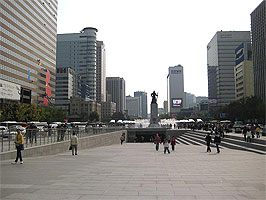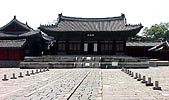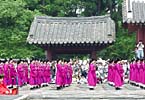
Jong-no |
| Life in Korea rating: N/A |
Average member rating:
N/A (0 ratings) |
|
|
  Jong-no is one of Seoul's representative business districts established along major streets. As the center of Seoul for the past 600 years since the establishment of the Joseon Dynasty, Jong-no has been played important roles as the heart of culture and administration and is the primary administrative area among Seoul's 25 districts. The name Jong-no was designated on April 1, 1943, and originated from the tower holding the bell to let people know of the opening and closing hours of Doseong-mun (one of the gates around the city). A milestone in the northeast area of Sejong-no serves as the origin for all the milestones in the country, implying that Jong-no is the center of the Korea.
Jong-no is one of Seoul's representative business districts established along major streets. As the center of Seoul for the past 600 years since the establishment of the Joseon Dynasty, Jong-no has been played important roles as the heart of culture and administration and is the primary administrative area among Seoul's 25 districts. The name Jong-no was designated on April 1, 1943, and originated from the tower holding the bell to let people know of the opening and closing hours of Doseong-mun (one of the gates around the city). A milestone in the northeast area of Sejong-no serves as the origin for all the milestones in the country, implying that Jong-no is the center of the Korea.
It is a popular shopping area, with several large shopping areas (Dongdae-mun Market, Seun Arcade, Gwangjang Market), as well as many famous places for books (Youngpoong Book Store, Kyobo Book Center), medical supplies (Oriental medicine, pharmacies, medical equipment), and jewelry.
 
 

The area is also the location of numerous cultural assets, including Bugak-san and Inwang-san (mountains), Gyeongbok-gung and Changgyeong-gung Palaces, Jongmyo Shrine, Sajikdan Altar and, Dongdaemun Gate. Additionally, numerous government facilities (both Korean and foreign) are located here, including embassies (U.S., Japan, Australia), the major Gwanghwamun Post Office, and the National Tax Service.
 
 

With its well-preserved traditional hanok (traditional style Korean buildings) among modern office buildings, the Jong-no area embodies a fusion of the traditional and modern.
|
|
|
Member Comments:
No ratings posted yet.
Rate this destination
|
Transportation:
Subways:
Changsin-
Seoul Line 6 (yellow)
Dongdaemun-
Seoul Line 1 (red), Seoul Line 4 (blue)
Dongmyo-
Seoul Line 6 (yellow)
Gwanghwamun (Sejong Cultural Center)-
Seoul Line 5 (purple)
Hyehwa-
Seoul Line 4 (blue)
Jonggak-
Seoul Line 1 (red)
Jongno O-ga (Chongno 5-ga)-
Seoul Line 1 (red)
Jongno Sam-ga (Chongno 3-ga)-
Seoul Line 1 (red), Seoul Line 3 (orange), Seoul Line 5 (purple)
|
|

|
|

|
|






